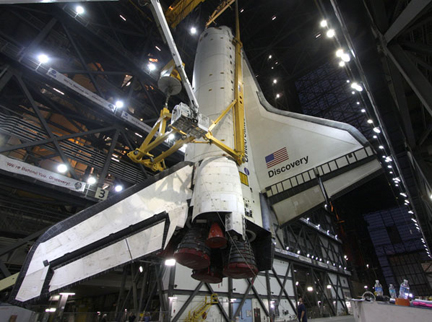Engineers troubleshoot shuttle/external tank attachment problem (UPDATED)
09/10/2010 12:54 PM Filed in: STS-133 | Space News
Editor's note...

The shuttle Discovery is hoisted vertical before work to attach the
orbiter to its external tank, visible in background at left.
(Photo: Spaceflight Now/Stephen Clark) Discovery was moved from its processing hangar to the Vehicle Assembly Building Thursday. A large sling was attached to the orbiter late in the day and the shuttle was rotated vertical and lifted into the high bay where its external tank and boosters were waiting. Roll out to launch pad 39A is scheduled for the evening of Sept. 20. Launch is targeted for Nov. 1.
A NASA spokesman said the problem occurred as engineers were attaching the left-side main separation bolt, part of the system used to ensure the shuttle separates from its external tank after reaching orbit.
Engineers initially worried Discovery would have to be removed from the tank and placed back in a horizontal orientation to make repairs. But they later concluded they could safely open the aft compartment, set up access platforms and reposition the nut with Discovery in its current vertical and partially mated configuration.
Late Friday, managers approved the plan, clearing engineers to remove an access door on the left side of the engine compartment. Assuming no problems getting the door off -- there was a possibility of binding due to loads on the door in the vertical orientation -- engineers planned to photograph the liquid hydrogen main separation nut and its mounting fixture.
The nut then was to be removed, inspected and threaded onto the bolt. A technician planned to remain in the aft compartment while the nut was torqued to 250 foot pounds, the requirement for a so-called "soft mate." At that point, if no problems were encountered, personnel planned to leave the compartment and re-install the left-side access door.
Roll out to the launch pad remains targeted for Sept. 20.
Discovery is scheduled to blast off Nov. 1 on its 39th and final mission, a flight to deliver supplies and a cargo storage module to the International Space Station. Before a water main break that delayed Discovery's roll over to the VAB by one day, engineers had 13 days of contingency time built into the processing schedule.
If Discovery is not off the ground by Nov. 5, the flight could face a lengthy delay because of conflicts with upcoming spacewalks, Russian and European launches and so-called "beta angle cutouts," periods when the angle between the sun and the plane of the space station's orbit results in extreme temperatures.
- Updated at 2:30 PM EDT: Engineers review plan to fix bolt problem without removing shuttle Discovery from its external tank.
- Updated at 5:55 PM EDT: Engineers cleared to enter shuttle aft in vertical configuration, re-install misaligned nut and proceed with shuttle/external tank mating

orbiter to its external tank, visible in background at left.
(Photo: Spaceflight Now/Stephen Clark)
A NASA spokesman said the problem occurred as engineers were attaching the left-side main separation bolt, part of the system used to ensure the shuttle separates from its external tank after reaching orbit.
Engineers initially worried Discovery would have to be removed from the tank and placed back in a horizontal orientation to make repairs. But they later concluded they could safely open the aft compartment, set up access platforms and reposition the nut with Discovery in its current vertical and partially mated configuration.
Late Friday, managers approved the plan, clearing engineers to remove an access door on the left side of the engine compartment. Assuming no problems getting the door off -- there was a possibility of binding due to loads on the door in the vertical orientation -- engineers planned to photograph the liquid hydrogen main separation nut and its mounting fixture.
The nut then was to be removed, inspected and threaded onto the bolt. A technician planned to remain in the aft compartment while the nut was torqued to 250 foot pounds, the requirement for a so-called "soft mate." At that point, if no problems were encountered, personnel planned to leave the compartment and re-install the left-side access door.
Roll out to the launch pad remains targeted for Sept. 20.
Discovery is scheduled to blast off Nov. 1 on its 39th and final mission, a flight to deliver supplies and a cargo storage module to the International Space Station. Before a water main break that delayed Discovery's roll over to the VAB by one day, engineers had 13 days of contingency time built into the processing schedule.
If Discovery is not off the ground by Nov. 5, the flight could face a lengthy delay because of conflicts with upcoming spacewalks, Russian and European launches and so-called "beta angle cutouts," periods when the angle between the sun and the plane of the space station's orbit results in extreme temperatures.